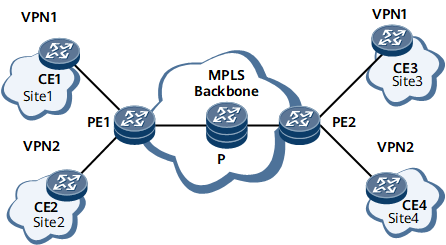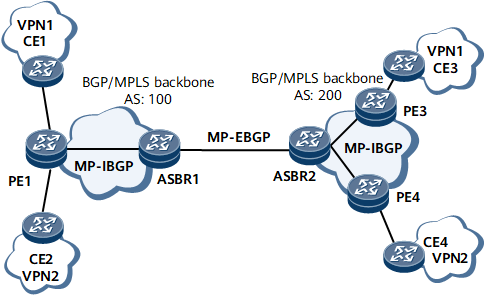BGP/MPLS IP VPN Label Allocation Modes
Background
In BGP/MPLS IP VPN networking, a device assigns a VPN label (MPLS label) to each VPN instance by default. On a network with a large number of VPN routes, the one-label-per-instance mode helps conserve label resources and reduce PE capacity requirements. Table 1 describes three label allocation modes that are supported.
Mode |
Description |
Applicable Networking |
Where to Configure |
|---|---|---|---|
One-label-per-instance |
All VPN routes from a VPN instance are assigned the same VPN label. |
All types of BGP/MPLS IP VPNs |
Devices on which VPN instances are configured |
One-label-per-route |
A label is assigned to each VPN route. |
All types of BGP/MPLS IP VPNs |
Devices on which VPN instances are configured |
One-label-per-next-hop |
All routes with the same next hop and VPN label are assigned the same label. |
Method 1: The one-label-per-next-hop mode configured in the BGP VPN instance IPv4 or IPv6 address family is mainly applicable to inter-AS VPN Option B networking. Method 2: The one-label-per-next-hop mode configured in the VPN instance view is applicable to all BGP/MPLS IP VPN networking. |
Method 1: ASBRs in inter-AS VPN Option B networking Method 2: Devices on which VPN instances are configured |
Implementation
One-label-per-instance
After one-label-per-instance label distribution is configured in a VPN instance IPv4 or IPv6 address family, all VPN routes from such an address family share the same VPN label. On the network shown in Figure 1, PE1 has two VPN instances: VPN1 and VPN2. If PE1 receives 10,000 VPN routes from sites of VPN1 and VPN2, respectively, by default, PE1 assignsonly one label to the 10,000 VPN routes received from each of VPN1 and VPN2.
One-label-per-route
After the one-label-per-route function is configured in the VPN instance IPv4 or IPv6 address family view, each VPN route is assigned a label. During the forwarding of private network packets, the packets are forwarded directly to the next hop whose information is carried in a label, and the forwarding speed is fast.
One-label-per-nexthop
By default, an ASBR or PE assigns a label to each VPN route. Alternatively, you can enable one-label-per-next-hop label allocation. After one-label-per-next-hop label allocation is enabled on an ASBR or PE, the ASBR or PE re-advertises an MP-BGP Update message to its peers. Each MP-BGP Update message carries a VPNv4 route and a label re-allocated based on the next hop. After a peer receives the MP-BGP Update message, the peer updates its local label forwarding table and re-establishes an LSP. After the label forwarding tables of the ASBR or PE and its peers are updated, service traffic is forwarded according to the new label forwarding table.
One-label-per-next-hop label allocation is applicable to VPN routes learned by PE1 and peer routes learned by ASBRs:
Method 1: On the network shown in Figure 2, two VPN instances named VPN1 and VPN2 are configured on PE1 in the inter-AS VPN Option B scenario, and the label distribution mode is one-label-per-route. If 10,000 VPN routes are imported to CE1 and CE2 belonging to VPN1 and VPN2, respectively, 20,000 labels are consumed when ASBR1 advertises 20,000 routes learned from PE1 to ASBR2. After one-label-per-next-hop label allocation is enabled on ASBR1, ASBR1 allocates only one label to the VPN routes with the same next hop and outgoing label. In this case, ASBR1 only needs to allocate two labels to the 20,000 routes.
Method 2: On the network shown in Figure 2, two VPN instances named VPN1 and VPN2 are configured on PE1 in the inter-AS VPN Option B scenario. Each of CE1 and CE2 belonging to VPN1 and VPN2, respectively, sends 10,000 VPN routes to PE1. If the label allocation mode is one-label-per-route, 20,000 labels are consumed when PE1 advertises 20,000 routes to ASBR1. After one-label-per-next-hop label allocation is enabled on PE1, PE1 allocates only one label to the VPN routes with the same next hop and outgoing label. In this case, PE1 only needs to allocate two labels to the 20,000 routes.

The one-label-per-route mode and one-label-per-next-hop mode can be flexibly switched to each other. During label allocation mode switching, service packets are lost for a short period due to the update of label forwarding tables.
In the inter-AS VPN Option B scenario, one-label-per-instance label allocation must be configured on PEs if one-label-per-next-hop label allocation is configured on ASBRs.
Benefits
Using an appropriate label distribute mode conserves label resources.

